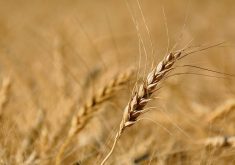Provincial ag extension staff in Alberta are reminding wheat growers they’ve got plenty of economic reasons to keep a weather eye out for signs of leaf spot disease.
Leaf spot diseases can decrease wheat yield by up to 20 per cent or more, as well as diminish kernel weight and in some cases reduce grade. When disease risk levels are moderate to high, protection of the upper two leaves of a developing wheat plant with a timely in-crop fungicide application prevents significant losses.
Disease risk level increases when more of the following factors exist: weather conditions are favourable for disease development; cereal crops are frequently grown in the same field; the chosen wheat variety is susceptible to leaf diseases; yield potential is good; and wheat price is high, said Neil Whatley, crop specialist with AARD’s Ag-Info Centre in Stettler.
Read Also

Senft to step down as CEO of Seeds Canada
Barry Senft, the founding CEO of the five-year-old Seeds Canada organization is stepping down as of January 2026.
Whatley also cautioned not to ignore other cereals.
“While ‘tan spot’ and ‘septoria leaf blotches’ are the most common leaf spot diseases in wheat, diseases like ‘spot blotch’ affect all cereal crops,” sais Whatley. “These leaf spot pathogens survive on infected straw residue and stubble from cereal crops grown during the previous two to three years in a particular field.
“A prolonged period of rainfall, fog or heavy dew raises the risk that these pathogens will produce spores and re-infect young, developing wheat plants. Under these humid conditions, temperatures of 15 to 27 C favour the development of ‘septoria leaf blotches’ while ‘tan spot’ prefers 20 to 28 C temperatures.”
Although leaf spot diseases can be present during early plant growth, scouting for cereal leaf diseases is especially important prior to, during and after flag leaf emergence. The appearance of moderate levels of disease in the lower canopy indicates there is a risk to the upper canopy leaves.
“Under conditions favourable for disease development, leaf spot disease symptoms appear as tiny brown or yellow spots or lesions on the leaf surfaces of seedlings and tillering wheat plants,” said Whatley. “Lesions contain spores that act as the disease transfer mechanism. Under prolonged humid weather conditions, the spots become more visible as they expand and blend together.
“If the weather turns dry in June and July, risk level diminishes as the leaf spot pathogens remain confined to the lower leaves, causing little overall harm. However, as upper leaves emerge on the developing wheat plants, wind or the splashing motion of rain drops can transfer spores from the lower canopy, and possibly from old infested crop residue, to the flag and penultimate (the leaf just below the flag) leaves, increasing the risk that key leaves for yield and grain filling may be compromised.”
A decision must then be made whether to protect the upper leaves with a foliar fungicide application, he said.
Spores that splash or are blown by wind onto the upper leaves germinate under favourable conditions, allowing the pathogens to infect leaf tissues, and cause premature browning of leaf surfaces, potentially resulting in significant loss of green leaf area.
Prevention of loss of green leaf area on the flag and penultimate leaves is the main concern, AARD said, as optimal sunshine on these leaves contributes to over 50 per cent of the wheat crop’s eventual yield.
“The goal is to apply a foliar fungicide when the flag leaf has just fully emerged if disease risk level is moderate to high,” said Whatley. “Generally, 20 per cent disease coverage of the area of the flag leaf results in a 10 per cent yield decrease, so preventing this amount of disease is usually desirable if yield potential is good and grain prices are fair to high.
“If a fungicide application is made and weather conditions favourable for disease development persist, a second fungicide application may be necessary,” he added.
Spraying too early or spraying too late results in poor disease control. While the idea of mixing a half rate of fungicide with a late herbicide application may seem convenient, given that the flag and penultimate leaves aren’t fully formed, the practice doesn’t directly protect the upper canopy leaves and is generally not economical. It’s preferable to prevent leaf spot diseases with a full rate of fungicide at the flag leaf stage.
However, spraying too late, after the disease is well established on the flag and penultimate leaves, is also not economical because significant green leaf area has already been lost and the fungicide doesn’t cure infected leaf tissue, but instead protects healthy leaf tissue.
“Whether fungicide choice is a systemic or a contact mode of action, the fungicide should be applied directly to the leaves that are important for grain filling,” said Whatley. “Leaf spot pathogens can become resistant to a specific fungicide, so if disease pressure is high enough to spray in successive years in a certain field, rotate fungicide modes of action.” — AGCanada.com Network















